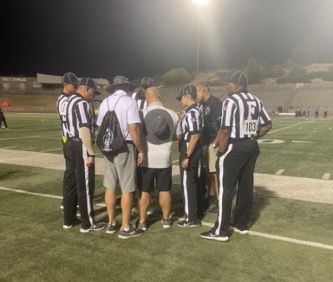Article
Pigskins and perception: How neuro-ophthalmology influences NFL referees
Author(s):
Every football fan knows the scrutiny that NFL game officials are put under every game day, and now a group of ophthalmologists is trying to ensure they can perform at their best each weekend.
A 2-day camp aimed at providing fundamental officiating techniques to high school and college football officials ws held in El Paso, Texas.(Image courtesy of James Hill, MD)

Every football fan knows the scrutiny that game officials of the National Football League are put under every game day, and now a group is trying to ensure they can perform at their best each weekend.
Walt Anderson, a retired dentist and current senior vice president of NFL Officiating Training and Development, aspires to bring science to the training of NFL officials. Anderson decided to reach out to Andrew Lee, MD, a neuro-ophthalmologist and fellow Houston native, to start a collaboration that brings medical science to the world of NFL officiating.
But why neuro-ophthalmology (NOP)? Despite worn out jokes about referees’ eyesight, visual acuity is likely not relevant to improving the accuracy of game officials’ calls—game officials are required to have eye exams, after all. Anderson sought to dive deeper into the science of dynamic visual processing to understand what is happening in officials’ brains when they are on the field. Many mechanics involved in NOP, such as visual field, saccades, smooth pursuit, and the vestibulo-ocular reflex (VOR), have direct and tangible implications in officiating.
Our on-field work experience began in El Paso, Texas. Anderson, in conjunction with other senior officiating staff members, held a 2-day camp aimed at providing fundamental officiating techniques to high school and college football officials. The first day began with a talk from Anderson, highlighting the basis of his “Move With Purpose” teachings Afterward, participants attended multiple sessions regarding position-specific curricula to prime them for the evening’s event—direct application through high school football scrimmages.
Each position (8) had specific on-field responsibilities, with constant feedback from coaches between plays. Throughout the games, drones were flown overhead to film footage and provide almost instantaneous replay for breaking down previously made calls and pulling up prior film for demonstrative purposes of topics, ranging from line of sight to VOR.
During the second day of the program, most of the time was spent on video review as an aid for further position development. Participants spent time watching drone videos from the day before, as well as actual NFL game recordings. Throughout the video review, NOP concepts were highlighted and displayed either in correct or incorrect manners. It was excellent to experience Anderson’s teachings in action to potential future NFL game officials. However, this was not the end of our journey involving the intersection between NOP and the NFL.
Lee and Anderson rendezvoused to Plano, Texas, for an officiating training conference, where Lee delivered a presentation on NOP to 17 head referees, along with other officiating staff and personnel. Specifically, crew leaders were instructed in principles regarding visual field, saccades vs smooth pursuit, dynamic visual acuity, and the VOR.
The floor was then opened for questions. Most queries revolved around what exercises officials could do to enhance their abilities in these areas. These questions led to productive conversations about how the NOP principles being taught are innate but can be harnessed through conscious effort to enable officials to observe the right place at the right time to make the right call.
Referees were encouraged to consider 3 main points: Do I have an unobstructed view of the play? Do I have to move to see what I need to see? If I do have to move, how do I get there with minimal disruption of my visual acuity? These points were emphasized in Anderson’s instructional modules to the referees. In addition to clarifying new rules and methods through video review, Anderson used game footage to demonstrate examples in which officials executed—or failed to execute—the NOP principles taught earlier by Lee.
Aside from formal instruction, Lee’s NOP team built personal relationships with the NFL officiating crew while in Plano. Perhaps the most impressive realization was the striking similarities between the work carried out by NFL officials and neuro-ophthalmologists. For instance, one head referee remarked that knowing the rule book was not the tough part of officiating, but it was knowing the exceptions—so, too, in NOP. Patients do not always present in a textbook fashion, and knowing the nuances can mean life or death. At the end of the day, both officials and eye physicians are trying to make the right call, whether for the integrity of the game or for the patients they care for.
The collaboration between the NFL and NOP is still in its infancy. However, exciting developments and studies are on the horizon. How do we leverage the powerful video data available to effectively teach the principles of NOP? Can we use virtual reality technology to train officials in a variety of realistic scenarios and conditions?
As one referee suggested: Would viewing film at twice the speed induce a slow-motion effect in real-game officiating, thus speeding cognitive processing? The relationship between sports and science will continue to develop as we pioneer answers to questions such as these.
Ashtyn Zapletal, Brent Woodland and Michael Carter also contributed to this report.
Newsletter
Don’t miss out—get Ophthalmology Times updates on the latest clinical advancements and expert interviews, straight to your inbox.





